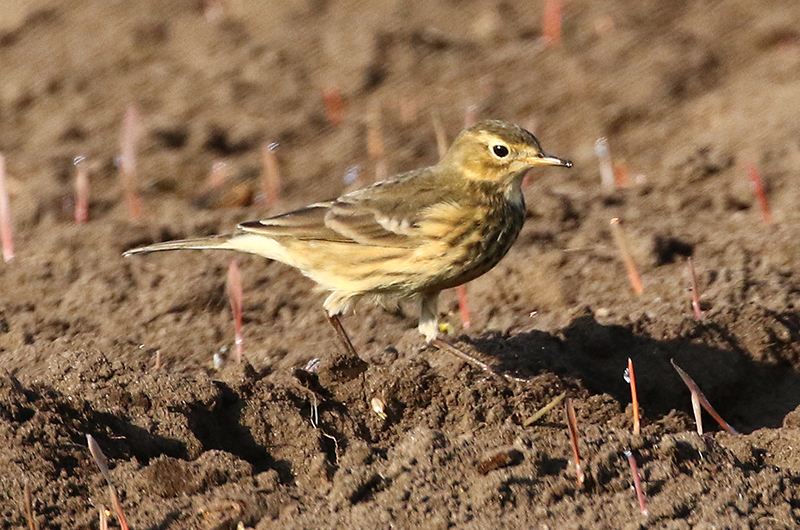There are signs on beaches where piping plovers, American oystercatchers and several species of terns usually nest. The signs are there because nests are hard to find and beachgoers could easily interrupt incubation by relaxing too close to the nest. There are a number of predators — especially crows and gulls — that will take advantage of even a short disturbance to steal and eat eggs from the nest.
It is important to respect these beach-nesting birds. The individuals starting their nests now are the older, more experienced birds that fledge more youngsters. If these nests are allowed to be successful, the young will have fledged by July 4. Look around these posted areas and please share the beaches by using the nearby beaches that are not posted.
By the way, plover can be pronounced two ways: like the o in over or like the o in lover. Either way, we will know what you are talking about.
This species is smaller than a black-capped chickadee. When you see one of these little gray and white mites, they seem to be mostly tail. Ken Magnuson spotted a blue-gray gnatcatcher at Mytoi on April 17. He also spotted a kestrel at Wasque that day. The day before that, Ashley Rathman found two kestrels at Wasque April. On April 15, John Nelson saw a kestrel at the Farm Institute. Another small falcon — a merlin — was found at Wasque on April 12 by Shea Fee. She also spotted three American pipits there.
A brown thrasher is the least common of the mimic thrushes; both catbirds and mockingbirds are much more common. Brown thrashers are found in shrubs, thickets and gardens. Roger Cook spotted a brown thrasher at Squibnocket on April 14.
The species mentioned in the rest of this column are migrants whose first sightings have already been reported.
John Nelson reports three snowy egrets were at Farm Pond on April 15, the same day that Amanda Williams and Ashley Rathman found two snowies and two great egrets at Felix Neck. Iris Freeman and Warren Woessner found a snowy at Sheriff’s Meadow Sanctuary on April 16, the same day that Lisa Maxfield spotted two snowies and one great egret at Brush Pond. Jeff Bernier found the Sheriff’s Meadow snowy on April 17.
A couple more immature male indigo buntings showed up this week.
On April 14 Mary Baptiste spotted an indigo bunting in her yard and Whitney Moody saw one on April 17.
Eastern towhees — I prefer the former name of rufous-sided towhee — are reaching their summertime abundant status. There are seven new sightings this week. Margaret Curtin saw two on April 12 at Ephraim Allen Road in West Tisbury. On April 15 Pat Ingalls spotted a few towhees at Great Rock Bight and that same day Amanda Williams and Ashley Rathman found one at Felix Neck. Allen Slater had one visit his Chappaquiddick feeder on April 16. Sioux Eagle welcomed a male and a female back to her feeders on April 17, the same day that Kathleen Kinsman’s returned. Amanda Williams and Ashley Rathman spotted three towhees on April 17 at Trapp’s Pond.
Eastern phoebes are also becoming more common, although mine has yet to show up. Anne Whiting spotted two at Quenames on April 10. Lanny McDowell spotted his first phoebe at home on April 12, the same day that Laura Lennihan spotted two at the Oak Bluffs pumping station. Jennifer Strachan saw one at Long Point on April 12, Margaret Curtin found one along Ephraim Allen Road in West Tisbury on April 13, Sea Williams and Bridget Dunnigan spotted two on April 14 in the northeast corner of the state forest. Amanda Williams and Ashley Rathman saw one on April 16 at Cedar Tree Neck and Margaret Curtin found one at Presbury Norton Preserve on April 18.
Right about now is the peak migration period for northern flickers, so large gatherings are expected. Lanny McDowell birded the Aquinnah Circle on April 13 and spotted 15 to 20 of them, while Lindsay Allison counted 20 on Chappaquiddick on April 14. This contrasts to the three flickers visiting my suet feeder every day.
White-throated sparrows are winter residents heading further north to nest; they are almost at the peak volume of their northward migration. Sharon Pearson spotted one at her feeder on April 10 while one showed up at Tim Rush’s feeder on April 12. They were still present at Holly Mercier’s feeders as of April 14. Amanda Williams and Ashley Rathman found five at Felix Neck on April 15 and four others at Trapps Pond on April 17. I saw two at my feeders on April 16; they are probably migrants as it has been a month since their last sighting.
Dark-eyed juncos will soon be leaving for more northern climes. Shea Fee saw one at Wasque on April 12 and Angel Morris spotted three at the West Chop end of Franklin street the next day. On April 14 Bob Shriber found one in Aquinnah.
Other sparrow news includes Angel Morris’ chipping sparrow and field sparrow at the West Chop end of Franklin street on April 13, and Amanda Williams and Ashley Rathman’s three savannah sparrows at Long Point on April 17.
Some springs produce an amazing show of thousands of northern gannets. Not this year; perhaps they are migrating further out to sea. Bob Shriber spotted 32 gannets off shore of the Aquinnah Cliffs on April 14, Shea Fee spotted 40 off Wasque on April 16. Amanda Williams and Ashley Rathman spotted one off shore from Long Point on April 17.
Please email your sightings to birds@mvgazette.com
Robert Culbert is an ecological consultant with Nature Watch LLC living in Vineyard Haven.













Comments
Comment policy »